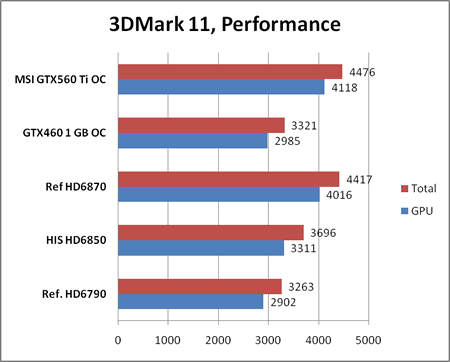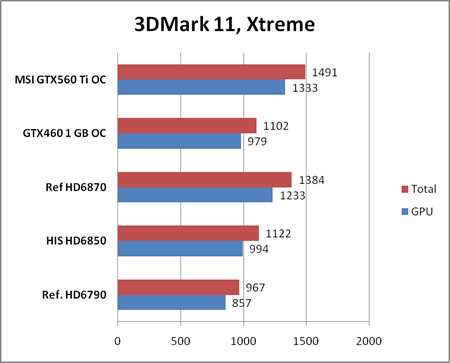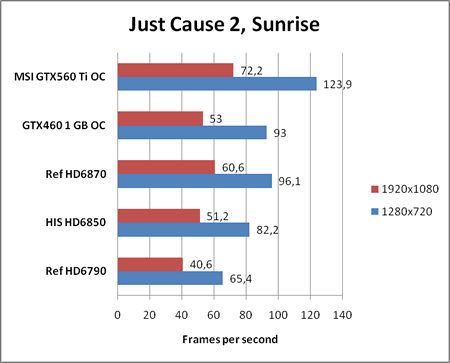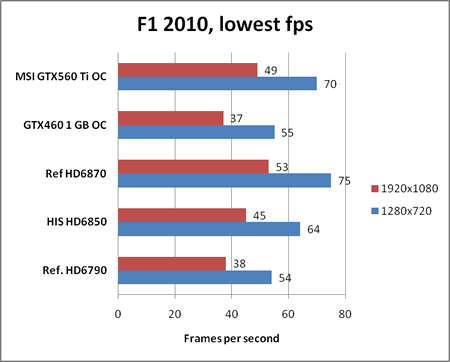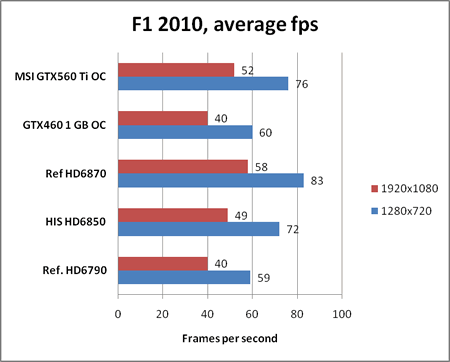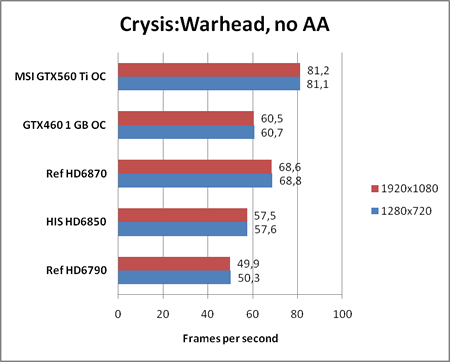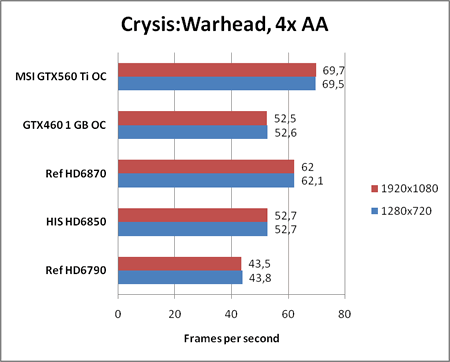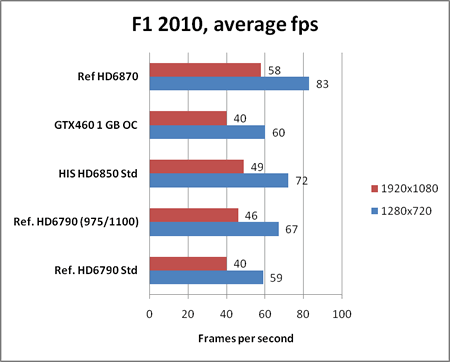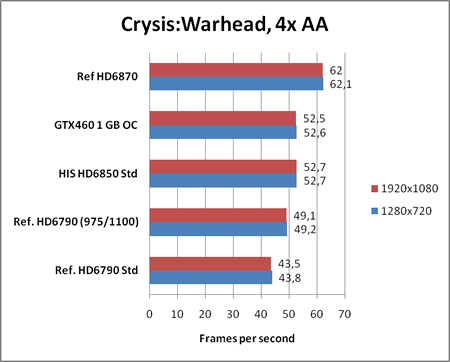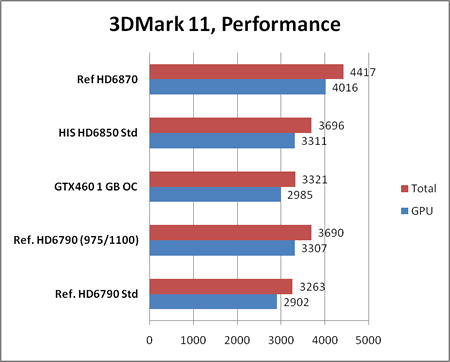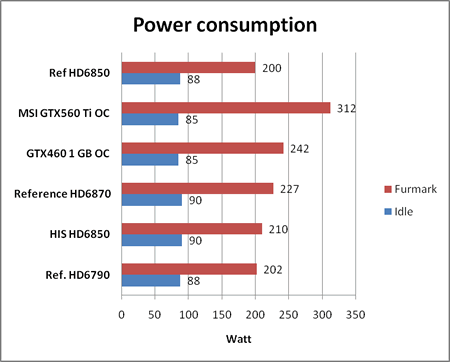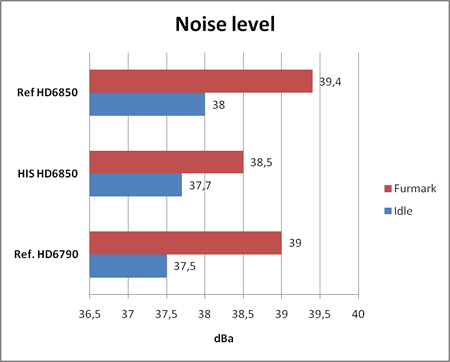The AMD HD6790 is aimed to bridge the gap between the HD5770 and the HD6850. In essence it is a lesser version of the HD68xx series. Read on to find out what it can do.
INTRODUCTION
With the newly introduced Radeon HD6790, AMD continues its work in extending the HD6xxx-series of GPU to every performance and price range. The GPU is based on the 40mm Barts GPU which we find also in the HD6850 and the HD6870. Aimed at the gap between the HD5770 and the HD6850, the HD6790 comes with an attractive price point (around $149/€129), and is also aimed to compete with NVIDIA’s GeForce GTX550 Ti.
SPECIFICATIONS
As this card is essentially a cut down HD6850, it comes with similar specifications.
| Feature/Specification | HD 6870 | HD 6850 | HD6790 | HD5770 |
|---|---|---|---|---|
| GPU |
Barts XT |
Barts Pro | Barts LE | Juniper XT |
| Core Clock |
900 |
775 | 840 MHz | 850 MHz |
| Memory |
GDDR5 |
GDDR5 |
GDDR5 |
GDDR5 |
| Memory interface |
256 bit |
256 bit |
256 bit |
128-bit |
| Stream Processors |
1120 |
960 | 800 | 800 |
| ROPs | 32 | 32 | 16 | 16 |
The HD6790 has fewer stream processors and ROP’s than the HD6850/HD6870. We will see how that affects performance in the next few pages.
CLOSER LOOK
As we only got the reference card so far (a HIS HD6790 ICeQ X-card is on its way to us), we will go over the card design briefly before moving to the benchmarks.
The reference card is rather large, at 9″, and it certainly does look more like the HD6870 than the HD6850. The cooler is in the rear and air is sucked in from the rear of the card and then pushed out the card’s ventilation grille, taking heat from the GPU and the memory while it passes.
As with the HD6850 and HD6870 we get 2 mini-DP connectors, one HDMI 1.4-connector and two DVI connectors (one dual-link and one single-link).
The card needs power from two 6-pin PCI-E power connectors, pulling 150W.
TESTING & METHODOLOGY
| Our test bench | |
|---|---|
| CPU |
Intel Core i7 2600K @ 4.7 GHz |
| Motherboard |
Asus P8P67 Pro |
| Memory |
8 GB DDR3 Kingston |
| Boot disk |
OCZ Vertex 2 |
| Video Cards | Reference HD6790 HIS HD6850 Reference HD6870 Gigabyte GTX460 1 GB OC MSI GTX560 Ti OC |
| PSU |
Thermaltake GRAND 750W |
| OS | Windows 7 Home Premium 64-bit with SP1 |
| Video drivers | AMD cards: Catalyst 11.4 beta NVIDIA GTX460 1 GB: 266.58 NVIDIA GTX560 Ti: 266.66 |
| Benchmarks | |
|---|---|
| 3DMark Vantage |
DX10, “Performance” |
| 3DMark 11 |
DX11, “Performance” and “Xtreme” |
| Formula F1 |
DX11, “Ultra” preset, 8xAA |
| Just Cause 2 |
DX11, 8xAA/16xAF, Everything set to max except NVIDIA specific settings which are turned off. Dark Tower and Sunrise benchmark. |
| Crysis: Warhead |
DX10, “Enthusiast” preset, no AA and 4xAA |
| Power consumption |
We measure the power draw at the wall both at idle and when running Furmark at 1920×1080. The resulting number includes all the components of the system except the monitor. |
| Temperature | We measure the temperature after 30 minutes running Furmark at 1920×1080. |
| Noise | We measure the noise level using a noise level meter 1 meter from the rear of the card. |
SYNTHETIC BENCHMARKS
Our first batch of benchmarks are synthetic benchmarks, which try to simulate a real life situation.
3DMark Vantage
3DMark Vantage is still one of the most popular benchmarks even though it is getting a bit old now. It lets us benchmark the DX10 performance of the cards.

For info on how and on what we tested this,
see our Testing & Methodology page
As expected the HD6790 trails behind the other cards. We were hoping to see it a bit closer to the GTX460 OC as that card is just a bit faster than the GTX550.
“3DMark 11 is the latest version of the world’s most popular benchmark for measuring the graphics performance of gaming PCs. Designed for testing DirectX 11 hardware running on Windows 7 and Windows Vista the benchmark includes six all new benchmark tests that make extensive use of all the new features in DirectX 11 including tessellation, compute shaders and multi-threading. After running the tests 3DMark gives your system a score with larger numbers indicating better performance. Trusted by gamers worldwide to give accurate and unbiased results, 3DMark 11 is the best way to test DirectX 11 under game-like loads.”
For info on how and on what we tested this,
see our Testing & Methodology page
While trailing all cards, the HD6790 does edge close to the GTX460 OC, at least in the performance test. As we turn up the settings to extreme it cannot keep up.
DX 10 GAMING: JUST CAUSE 2
“Just Cause 2 is an open world action-adventure video game. It was released in North America on March 23, 2010, by Swedish developer Avalanche Studios and Eidos Interactive, and was published by Square Enix. It is the sequel to the 2006 video game Just Cause.
Just Cause 2 employs the Avalanche Engine 2.0, an updated version of the engine used in Just Cause. The game is set on the other side of the world from the original Just Cause, on the fictional island of Panau in Southeast Asia. Panau has varied terrain, from desert to alpine to rainforest. Rico Rodriguez returns as the protagonist, aiming to overthrow the evil dictator Pandak “Baby” Panay and confront his former mentor, Tom Sheldon.”
For info on how and on what we tested this,
see our Testing & Methodology page
As we move to a proper game we quickly notice that the HD6790 cannot handle the highest quiality settings at 1920×1080. It probably is unfari to expect a $150-card to handle 8xAA and everything set to max at 1920×1080 so if you want playable framerates you need to lower the settings a bit. There is quite a big difference between the HD6790 and the HD6850 or GTX460 OC. Considering that you can get a HD6850 now for 10-15$ more(add a mail-in rebate and it can be cheaper) we did expect a bit more from the HD6790.
Next game to be tested is Formula F1, a new DirectX11 game that looks stunning.
DX11 GAMING: F1 2010
F1 2010 from Codemasters is a racing game that was launched late 2010. With full DirectX 11 support and lots of cool effects, including weather, it is a game that offers tons of eye-candy.
For info on how and on what we tested this,
see our Testing & Methodology page
F1 2010 is an interesting game as it works very well on AMD cards. Here we see that the HD6790 actually manages to get scores similar to the GTX 460 OC, which is impressive.
DX10 GAMING: CRYSIS WARHEAD
Crysis Warhead is the much anticipated standalone expansion pack to Crysis, featuring an updated CryENGINE™ 2 with better optimization. It was one of the most anticipated titles of 2008.
For info on how and on what we tested this,
see our Testing & Methodology page
Whereas the EGO engine of F1 2010 favoured AMD cards, the CryEngine 2 used in Crysis Warhead favors NVIDIA cards, including the GTX 460 OC. Here the HD6790 is soundly beaten by all cards, and again isn’t even close to the HD6850.
OVERCLOCKING
Our review of the HIS HD6850 has shown the HD 6850 is a very good overclocker. Does that also extend to the HD6790?
Unfortunately the latest beta of Sapphire’s excellent overclocking program Trixx couldn’t make heads or tails of our HD6790, so we used the regular Catalyst Control Center for our overclocking attempts.
We tested each overclock by running the burn-in test in Furmark at 1920×1080 for 30 minutes. If this worked without any errors we increased the settings a bit more. When we found the highest overclock we ran the card through almost all our benchmarks. If the card could handle all this without crashing we would accept the overclock as stable.
It turns out that the reference card is a good overclocker. We managed to increase the clockspeed from 840 MHz (GPU) /4200 MHz (memory) to 975 MHz (GPU) and 4400 MHz (memory). That is a nice 16% overclock on the GPU and a more modest 5% overclock on the memory.
Just as with the HD6850, the HD6790 really uses the extra horsepower, propelling it closer to (or past) the more expensive GTX460 OC and closer to a regular HD6850. We cannot wait to see what companies like HIS and Sapphire can do with this GPU.
TEMPERATURES
Even at full load the card does not get hotter than the other AMD cards. Compared to the reference HD6850 it is actually better. Since the OEM’s most probably will put their own coolers on their cards like they have done with the HD6850, these results only show that the card has good cooling potential.
POWER CONSUMPTION
Power consumption was measured for the complete system
(excluding the monitor) at the wall.
At idle (Windows desktop) all cards are equal with very minor differences, which are within the sample error. As we put full load onto the cards, the HD670 manages to keep itself at the lowest temperature.
NOISE LEVEL
We had some issues measuring the noise level of the graphics cards alone as the whole system had to be on while we did the testing. In the system we also have a Noctua 140mm-fan and a Thermaltake GRAND PSU which both added to the noise level.
At full load the fan of the HD6790 only spins at around 40-45% speed and while it is audible, the card has a very soft sound.
CONCLUSION
The HD6790 is AMD’s latest card aimed at the $150 mid-level market between the HD5770 and the HD6850. It performs pretty well and can even handle many games at the highest quality settings, something that is nice for a card around $150/€129. However, just as NVIDIA initially did with the GTX550 Ti, it seems that AMD might have priced this card a bit high compared to the HD6850. Today we can get a HD6850 for $165 which gives us a lot more performance compared to the HD6790. Instead of being a card between the HD5770 and the HD6850, based on the price, we would have expected this to card to replace the HD5770.
This isn’t a bad card and we certainly are curious what companies like HIS and Sapphire can do with it but the pricing of the cards will be the key on deciding if we would recommend it over a HD6850, a GTX550 Ti or a GTX460.
| OUR VERDICT: Radeon HD6970 | ||||||||||||||||||
|
||||||||||||||||||
| Summary: The HD 6790 is the latest card from AMD aimed to bridge the gap between the HD5770 and the HD6850. On the plus side we have good performance and lot of headroom for overclocking. On the negative side we find mainly the price that is to close to that of the HD6850. |
 Bjorn3D.com Bjorn3d.com – Satisfying Your Daily Tech Cravings Since 1996
Bjorn3D.com Bjorn3d.com – Satisfying Your Daily Tech Cravings Since 1996





